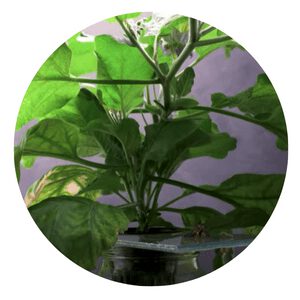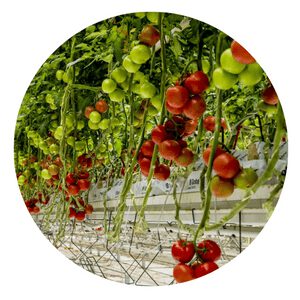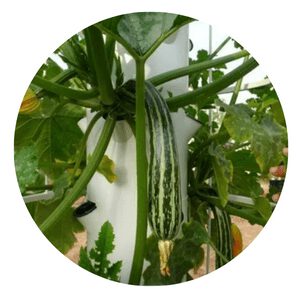How To Grow Kale Hydroponically
Kale is one of the most nutrient-dense foods on the planet, and growing it hydroponically is a great way to get the most out of this superfood.
Hydroponic kale is also incredibly easy to grow, and only requires a few simple supplies.
In this article, we’ll show you how to get started with hydroponic kale, including what you’ll need and some tips for success.
Table of Contents
What is kale and why grow it hydroponically?
Kale is a leafy green vegetable that is part of the cabbage family.
It is high in vitamins A, C, and K. It can be grown hydroponically, which is a method of growing plants without soil.
Hydroponic gardening has many benefits over traditional soil gardening.
Plants grown hydroponically require less water and fertilizer than plants grown in soil.
They also grow faster and produce more food per square foot than soil-grown plants.
Kale is a perfect plant to grow hydroponically because it is highly nutritious and easy to grow.
By growing kale hydroponically, you can provide yourself with fresh, healthy kale all year round!
Nutrients: what kind of nutrients does kale need?
Kale is a nutrient dense leafy green and an excellent source of vitamins A, C, and K. It is also a good source of manganese, copper, calcium, and iron.
However, like all plants, kale needs specific nutrients to grow properly.
In this article we will discuss the nutrients that kale needs and how to ensure your kale plants get enough of them.
Kale is a member of the brassica family, which includes other nutrient-rich leafy greens like collards and mustard greens.
All brassicas are rich in vitamins A, C, and K as well as minerals like manganese, copper, calcium, and iron.
Brassica plants are also a good source of fiber and antioxidants.
To ensure your kale plants get enough of these essential nutrients, it is important to fertilize them regularly.
Kale is a superfood that's hard to beat It's full of vitamins and nutrients And growing it hydroponically Is a great way to get your greens The best part about growing kale this way Is that you don't need soil or sun All you need is water and some light And soon you'll have healthy kale to eat
Chappy The Gardener
Lighting: how much light does kale need?
Kale is a leafy green vegetable that is part of the cabbage family. It is high in vitamins A, C, and K. It is also a good source of fiber and iron.
Kale can be grown hydroponically, which means that it does not need soil to grow. The plants are grown in a water solution that contains nutrients.
Kale needs a lot of light to grow well. The plants should be placed in an area where they will receive at least six hours of direct sunlight each day.
If you are growing kale indoors, you will need to provide artificial lighting for the plants.
Fluorescent lights are the best type of light to use for growing kale hydroponically.
Kale is a relatively easy plant to grow hydroponically.
pH levels: what pH levels are best for kale?
The pH level of the water is an important factor in growing kale hydroponically.
The ideal pH level for kale is between 6.0 and 7.0.
This range of pH levels will provide the plant with the nutrients it needs to grow healthy and strong.
If the pH level of the water is too high or too low, it can cause problems for the plant.
High pH levels can make it difficult for the plant to absorb nutrients, while low pH levels can make the plant more susceptible to disease.
Temperature: what temperature is best for growing kale?
Kale is a leafy green vegetable that is part of the cabbage family. It is a cool weather crop that can be grown in the spring or fall.
Kale can also be grown in the winter in areas with mild winters.
The ideal temperature for growing kale is between 60 and 65 degrees Fahrenheit.
If the temperature gets too hot, the leaves of the kale will turn yellow and become bitter.
If the temperature gets too cold, the leaves will turn red and become tough.
Kale can be grown hydroponically, which means that it does not need soil to grow.
The roots of the kale plant will grow in water that has nutrients added to it.
Hydroponic systems can be set up indoors or outdoors.
Harvesting: how and when to harvest kale?
The leaves of kale can be harvested individually, or the entire plant can be cut down and the leaves will regrow.
To harvest individual kale leaves, cut them at the base of the stem with a sharp knife.
Kale leaves can also be pulled off of the stem by hand. If you are harvesting an entire plant, cut the stem just above the soil line with a sharp knife.
You can also pull up the entire plant by its roots.
Kale should be stored in a cool, dark place until you are ready to use it.
Troubleshooting common problems when growing kale hydroponically
If you’re thinking about growing kale hydroponically, you might be wondering if it’s really worth the effort.
After all, kale is a relatively easy crop to grow in soil.
However, there are several benefits to growing kale hydroponically, including a shorter growth cycle and higher yields.
One of the most common problems that growers face when growing kale hydroponically is nutrient deficiencies.
Kale is a heavy feeder, so it’s important to make sure that your nutrient solution is well-balanced and up to par.
The best hydroponic systems for growing kale
Kale is a leafy green vegetable that is part of the cabbage family. It is a nutritional powerhouse and is loaded with vitamins and minerals.
Kale can be grown hydroponically, which is a method of growing plants without soil.
The best hydroponic systems for growing kale are the deep water culture system and the aeroponic system.
The deep water culture system involves suspending the roots of the plant in a nutrient-rich solution.
The roots are constantly oxygenated, which helps the plant to grow quickly.
The aeroponic system uses mist to deliver nutrients to the roots of the plant.
This system also provides high levels of oxygen to the roots, which helps the plant to grow quickly.
Tips for success when growing kale hydroponically
Kale is a powerhouse of nutrients and antioxidants, and growing it hydroponically is a great way to ensure a constant supply of fresh, healthy leaves.
Here are some tips for success when growing kale hydroponically:
1. Start with good quality seedlings or clones. Kale is a relatively easy crop to grow from seed, but starting with healthy plants will give you a head start on a successful harvest.
2. Make sure your nutrient solution is well balanced. Kale is a heavy feeder and will need plenty of nutrients to thrive. A good quality hydroponic fertilizer will provide everything your kale plants need.
3. Keep the roots moist but not waterlogged. Kale roots can rot if they are constantly wet, so make sure your growing system has good drainage and that you don’t overwater the plants.
In conclusion,kale is a great vegetable to grow hydroponically because it is easy to grow and maintain.
Kale is a superfood that is packed with nutrients, and it is a great addition to any diet.
Growing kale hydroponically is a great way to get your daily dose of greens, and it is a fun and rewarding experience.
Hydroponic FAQ
Hydroponics is a method of growing plants in a water-based solution. The roots of the plant are submerged in the solution, which provides nutrients to the plant. Hydroponics can be used to grow plants in any environment, including indoors or in areas with limited space.
Hydroponics is a great way to grow plants without using soil. Soil can contain harmful bacteria and pests that can damage plants. Hydroponics also allows for better control over the nutrient levels that plants receive. This means that plants can be grown faster and more efficiently.
Hydroponics is not only for professional growers anymore. Anyone can set up a simple hydroponic system at home with just a few supplies. All you need is a container, some water, and some nutrients for your plants. You can find all of these supplies at your local garden center or online.
Hydroponics is a method of growing plants in a water-based solution instead of soil. The roots of the plants are suspended in the solution, which is typically kept at a pH level between 5.5 and 6.5 and contains all the nutrients the plant needs to grow.
The water-based solution is circulated using a pump, and the oxygen in the water helps the roots to absorb the nutrients they need. The plants are grown in a controlled environment, which means that they can be grown year-round and don’t require as much space as traditional methods of farming.
Hydroponics is a efficient way to grow crops, and it’s often used by commercial growers to produce fruits, vegetables, and herbs.
Hydroponics is a type of gardening that uses mineral nutrient solutions, in water, without soil. Terrestrial plants may be grown with only their roots exposed to the mineral solution, or the roots may be supported by an inert medium, such as perlite or gravel. The main advantages of hydroponics over conventional farming are:
1) Hydroponics can be done on a smaller scale than traditional farming. This means that it is possible to set up a hydroponic system in your own home, without needing a lot of space.
2) Hydroponics does not require the use of chemical pesticides or herbicides. Because the plants are grown in a controlled environment, they are not subject to pests and disease in the same way that plants grown in soil are.
Hydroponics is a method of growing plants in water without soil. Although this type of gardening has many advantages, there are also some disadvantages to consider before starting a hydroponic garden.
One of the biggest disadvantages of hydroponics is the initial cost. Setting up a hydroponic system can be expensive, and it requires special equipment that may not be readily available. Additionally, hydroponic gardens require more maintenance than traditional gardens and may require additional expertise to troubleshoot problems.
Another downside to growing plants hydroponically is that they can be more susceptible to diseases and pests. Because the roots are exposed and the plants are grown in close proximity to each other, diseases can spread quickly throughout a hydroponic garden. Pests can also be difficult to control in a hydroponic system because they can easily hide among the plants.
Hydroponics is a gardening method where plants are grown in water instead of soil. The water is kept circulating and contains all the nutrients the plant needs to grow. You can set up a hydroponic system using different materials, but you will need some basic equipment to get started.
To start growing plants in a hydroponic system, you will need:
-A container to hold the plants and water. This can be anything from a plastic bucket to a fish tank.
-A way to circulate the water and deliver nutrients to the plants. This can be done with a simple pump and tubing or with a more complex aeration system.
-Grow lights if you are not growing your plants in natural sunlight.
-Plant food or nutrient solution to mix into the water.
A hydroponic system is a great way to grow plants without using soil. There are many different ways to set up a hydroponic system, but they all generally follow the same basic principles.
One of the most important things to consider when setting up a hydroponic system is the type of growing medium you will use. There are many different types of growing mediums available, and each has its own advantages and disadvantages. Some common types of growing mediums include gravel, sand, perlite, and vermiculite. Once you have decided on a type of growing medium, you will need to purchase enough to fill your chosen container.
Another important consideration when setting up a hydroponic system is the type of nutrient solution you will use. There are many different types of nutrient solutions available, and each has its own advantages and disadvantages.
Click To Grow Organic
Helps Us Grow – Share If You Like

















